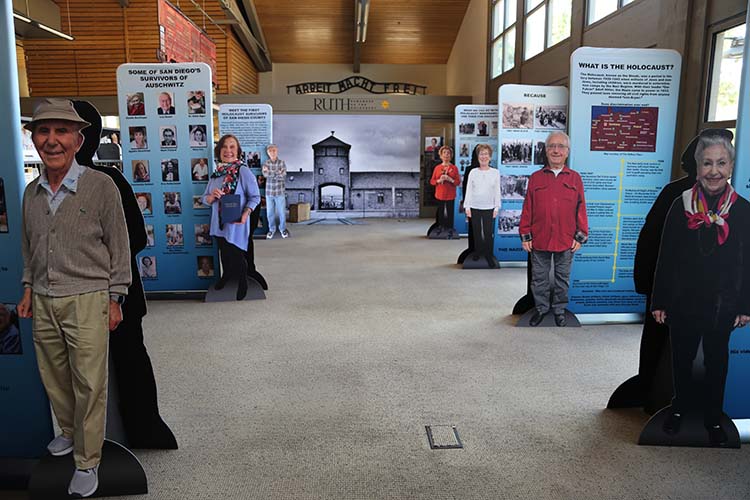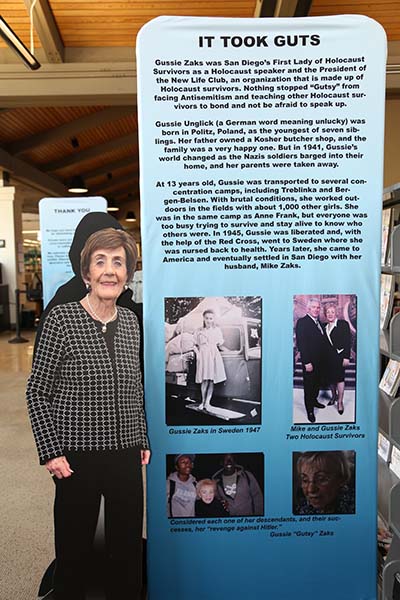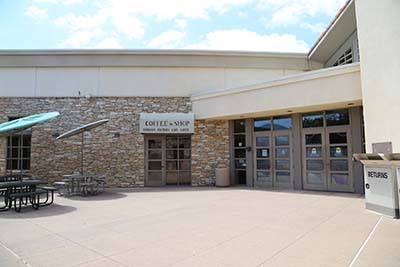
By Donald H. Harrison

EL CAJON, California – There is much to read in addition to the shelved books at the Rancho San Diego County Library. From now until next May 21, which will be the one-year anniversary of a Holocaust exhibition curated by Sandra Scheller, visitors can read on standing panels a brief timeline of the Holocaust and the experiences of some victims who suffered through it and later settled in San Diego County.

Contemporary life-size figures of the survivors, who later made their homes in this county, stand next to the panels, giving the exhibition a sense of immediacy. The exhibition capsulizes some of the experiences of survivors who had lived throughout Europe before the Holocaust. Adele Bein, from Holland, remembered watching her mother being kicked in the stomach by two Nazis. Vera Falus, from Hungary, recalled having her head shaved so that she could pose as a boy while in hiding. Anita Fuchs, from Romania, said her mother told her if anyone knocked at their door to hide under the bed. Ilona Medwied, from Poland, remembered being smuggled out of the Treblinka concentration camp and being hidden until the end of the war. Edith Palkowitz, from Hungary, will never forget Nazis kicking her down a flight of stairs, breaking her teeth. Manya and Mike Wallenfels escaped the Nazis in Hungary by hiding in forests, cemeteries and a swamp.
Ruth Goldschmiedova Sax, mother of the curator, was 10 years old when German Nazis marched through the town of Brno, Czechoslovakia. She was forced to wear a yellow star and banned from public school. In 1941, she was deported to the ghetto of Theresienstadt. Three years later with her mother, she was transported to Auschwitz, where they were forced to stand naked six times in front of Dr. Josef Mengele, who determined whether camp inmates should live or die. They were sent to the Oederan labor camp, where Ruth worked in a bullet factory until Russian troops liberated the camp. When she and her mother returned to Brno, Ruth’s father, who had been taken away from them, miraculously was waiting for them.
Some like Goldshmiedova Sax have recently died; others like the Wallenfels couple are still among the ever-shrinking number of Holocaust survivors who are still alive and telling their stories.
The exhibition relates that orphaned children, who in some cases saw their parents murdered by Nazi patrols, suffered great privations in hiding. They slept wherever they thought they might not be found. They were covered with lice, starving, and often suffered from typhus. “They went to sleep only to wake up next to those who died,” an exhibition panel related. “They covered their ears as they heard bombs. Some lost their teeth, some were all alone, families gone forever. They had nothing because they were Jewish.” Whose stories were these? The aforementioned Beim, Falus, Pakowitz, the Wallenfels as well as Lou Pechi and Harry Rosen.
The Six Million Jews who perished in the Holocaust were not the only victims that the Nazi haters put to death or imprisoned at hard labor for no reason other than being who they were. Blacks; Roma/ Gypsies; Gays; Political Enemies; Jehovah’s Witnesses; Disabled People, whether adults or children, were also on Hitler’s hit list.
World War II ended in 1945 with Germany surrendering and Hitler committing suicide. Survivors were liberated from the camps, but with no places to go, they languished for several years in Displaced Persons Camps. Immigration to the United States, and more particularly to San Diego, was underway by 1949. Four years later, the New Life Club was formed, in which survivors shared their dreams, provided support groups for one another, and eventually wrote books and gave speeches about their Holocaust experiences.
Among San Diego County Holocaust survivors who became authors were Werner Dreifuss, from Germany, who wrote The Epitome of the American Dream; psychologist Edith Eva Eger, from Hungary, who wrote The Choice and The Gift; Francheska Gelbart, who authored Frozen in Time; Fanny Krasner Lebovits, today over 100, who wrote Memories, Miracles & Meaning: Insights of a Holocaust Survivor; Ben Midler, who authored The Life of a Child Survivor from Bialystok, Poland; and Lou Pechi, from Croatia, who wrote I Am Lubo; A Hidden Life with Louis Pechi.
The late Gussie Zaks, from Poland, was described in the exhibition as “San Diego’s first lady of Holocaust survivors. As a Holocaust speaker and the President of the New Life Club… nothing stopped ‘Gutsy’ from facing antisemitism and teaching other Holocaust survivors to bond and not to be afraid to speak up.” In 1941 Nazis took her parents away from their home. At age 13, Gussie “was transported to several concentration camps, including Treblinka and Bergen-Belsen. Under brutal conditions she worked outdoors in the field with 1,000 other girls.” From later history, Gussie knew that the famed diarist, Anne Frank, was also at Bergen-Belsen in that time period, but they never met. “Everyone was too busy trying to survive to know who the others were.” After liberation, Gussie went to Sweden where she was nursed back to health. Years later, with husband Mike Zaks, she settled in San Diego.
Some artifacts used by Holocaust lecturers are referenced in the exhibit. There is a photograph of the uniform that David Fox was issued at a concentration camp. His daughter Sonia Fox Ohlbaum takes it with her when she speaks to groups about the Holocaust. A dress worn by curator Scheller’s mother, with a big X on its back, is also exhibited. When the Nazis ran out of the striped pajamas normally issued to prisoners, they had them pick from a pile clothes previously worn by murdered inmates. The clothes were marked with a big X on the back.
Each of those two pieces of clothing had stories attached to them. Fox was able to sew a place inside his uniform in which to secret a spoon. Goldshmiedova was able to hide a tiny Torah made from bread and spit into the hem of her dress. If that item had been spotted by the Nazi guards, she would have been executed.
Beyond a door is another room in which photos from concentration camps are shown, including people in barracks, people moments before they were killed by poisonous gas, and the interior of a gas chamber. There is a video playing of a survivor giving testimony about Holocaust experiences. And there are pictures of a fake shower head that spewed poisonous gas, a Nazi arm band, and of the poison gas canisters. A printed warning before one enters the room is that some of the images may be unsuitable for young children.
The exhibition poses questions and lessons for viewers. It asks if they were in the Holocaust what would they have done? And do they think they could have survived?
Some of the lessons were: 1) Never stop talking about the Holocaust. Your best information comes from a survivor. Ask questions and never stop asking them. 2) All people have a responsibility to prevent such an atrocity from happening again. We cannot turn our backs and we must use our voices. The Holocaust did not begin in a camp or gas chambers; it began with intolerance and hatred. It continued with propaganda and lies. We must seek the truth. 3) Remaining silent is the greatest sin…. 4) Holocaust education is the key. We must encourage the study of the Holocaust in all its dimensions …

A small panel expresses the hope that this year-long exhibition will lead to the creation of a permanent Holocaust museum in San Diego County. There are two free takeaways from the library located at 11555 Via Rancho San Diego in El Cajon. Both are expensively printed El Sol magazines from Southwestern College, which awarded Scheller an honorary degree at its most recent graduation ceremony in honor of her curating the predecessor exhibition shown at the Chula Vista Public Library titled “RUTH: Remember Us The Holocaust.” An issue in Spring of 2020 had Ruth Goldshmiedova Sax on its cover with the caption “Chula Vista’s beloved Holocaust survivor stared down Nazis to spread a message of peace.” In 2022, the cover of another issue pictured Rose Schindler, Benjamin Midler and Gerhard Maschowski showing the tattoos that were forced onto their arms. That article was headlined “Warriors for Peace.”
Curator Scheller offers tours of the exhibit every Thursday from 10:30 a.m. to 2 p.m.
*
Donald H. Harrison is editor emeritus of San Diego Jewish World. He may be contacted via donald.harrison@sdjewishworld.com
What words can one use to describe the horror and evil that was inflicted. What can cause such hatred for so many, the Jews, the disabled, the Gypsies, the mentally ill? It’s happening again, maybe not mass murder but the hatred. Antisemitic hatred is alive, hatred of the Christians, family values. Don’t be silent!